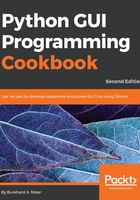
What this book covers
Chapter 1, Creating the GUI Form and Adding Widgets, explains how to develop our first GUI in Python. We will start with the minimum code required to build a running GUI application. Each recipe then adds different widgets to the GUI form.
Chapter 2, Layout Management, explores how to arrange widgets to create our Python GUI. The grid layout manager is one of the most important layout tools built into tkinter that we will be using.
Chapter 3, Look and Feel Customization, shows several examples of how to create a good look and feel GUI. On a practical level, we will add functionality to the Help | About menu item we created in one of the recipes.
Chapter 4, Data and Classes, discusses saving the data our GUI displays. We will start using object-oriented programming (OOP) in order to extend Python's built-in functionality.
Chapter 5, Matplotlib Charts, explains how to create beautiful charts that visually represent data. Depending upon the format of the data source, we can plot one or several columns of data within the same chart.
Chapter 6, Threads and Networking, explains how to extend the functionality of our Python GUI using threads, queues, and network connections. This will show us that our GUI is not limited at all to the local scope of our PC.
Chapter 7, Storing Data in Our MySQL Database via Our GUI, shows us how to connect to a MySQL database server. The first recipe in this chapter will show how to install the free MySQL Server Community Edition, and in the following recipes we will create databases, tables, and then load data into those tables as well as modify these data. We will also read the data back out from the MySQL server into our GUI.
Chapter 8, Internationalization and Testing, shows how to internationalize our GUI by displaying text on labels, buttons, tabs, and other widgets in different languages. We will start simple and then explore how we can prepare our GUI for internationalization at the design level. We will also explore several ways to automatically test our GUI using Python's built-in unit testing framework.
Chapter 9, Extending Our GUI with the wxPython Library, introduces another Python GUI toolkit that currently does not ship with Python. It is called wxPython, and we will be using the Phoenix version of wxPython, which was designed to work well with Python 3.
Chapter 10, Creating Amazing 3D GUIs with PyOpenGL and PyGLet, shows how to transform our GUI by giving it true three-dimensional capabilities. We will use two Python third-party packages. PyOpenGL is a Python binding to the OpenGL standard, which is a graphics library that comes built-in with all major operating systems. This gives the resulting widgets a native look and feel. PyGLet is another such binding that we will explore in this chapter. We will also show some code that directly uses the PyOpenGL library. This is a low-level approach that might open some doors for the interested reader.
Chapter 11, Best Practices, explores different best practices that can help us to build our GUI in an efficient way and keep it both maintainable and extendible. Best practices are applicable to any good code, and our GUI is no exception to designing and implementing good software practices.